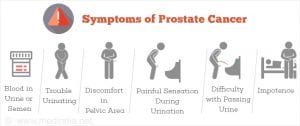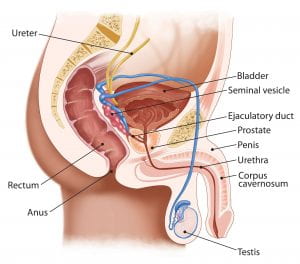Normal Physiology
The prostate is a small gland located midline in the body, inferiorly to the bladder and anterior to the rectum. The prostate surrounds the urethra which carries both urine and seminal fluid to the distal urethra. The prostate is a part of the male reproductive system, responsible for making and storing seminal fluid. Androgens are the male sex hormones and they primarily are testosterone and dihydrotestosterone. The prostate is also normally responsible for the conversion of dehydroepiandrosterone into testosterone, and then later in to dihydrotestosterone. The prostate is reliant on these hormones for normal function. Another major role of the prostate is to produce part of the seminal fluid that helps nourishes and transport semen as well as neutralize the acidic environment of the vagina.
(n.d.). Retrieved October 27, 2019, from https://www.prostateconditions.org/images/iStock-176986341.jpg.
Pathophysiology of prostate cancer
Prostate cancer is most often classified as adenocarcinomas, which is a neoplasm originating from glandular cells of the epithelial layer in the posterior lobe of the prostate. Prostate cancer is a multi-focal disease with known risk factors such as diet, hormonal imbalances, chronic inflammation and genetic/epigenetic factors. Diets with high caloric intake, high fats, red meats and diary products are associated with increased risks for prostate cancer. Hormonal changes in estrogen receptors α and β as well as Androgen receptor signaling all contribute to the disease process although exact changes are not yet fully known. The exact pathophysiology of prostate cancer is not yet fully understood.
(n.d.). Retrieved October 27, 2019, from https://ghr.nlm.nih.gov/art/large/stages-of-prostate-cancer.jpeg.
Other risk factors
Chronic inflammation from sources such as infectious agents, hormonal changes, physical trauma, urinary reflux, and dietary intake of carcinogens. All of which may all be important risk factors for the development of prostate cancer. “Genetic studies suggest a strong familial predisposition to prostate cancer. BRCA2 germline mutations have a 20-fold increase in risk for prostate cancers. Hypermethylation of the glutathione S-transferase gene is the most common epigenetic alteration and helps protect against carcinogen damage”. (McCance, Huether, Brashers, & Rote 2019). Those who are of African-American race, those who are older in age, and those who have a history of Agent Orange exposure also shown to have an increased risk of developing prostate cancer.
Clinical Manifestations
Clinical manifestations usually occur in late disease stages. Symptoms include slow urinary stream, hesitancy, incomplete emptying, frequency, nocturia, and dysuria, bone pain at sites of metastasis, edema in lower extremities, enlarged lymph nodes, mental confusion, bowel obstructions and impotence.
 (n.d.). Retrieved October 27, 2019, from https://www.medindia.net/images/common/patientinfo/950_400/symptoms-of-prostate-cancer.jpg.
(n.d.). Retrieved October 27, 2019, from https://www.medindia.net/images/common/patientinfo/950_400/symptoms-of-prostate-cancer.jpg.
Diagnostic tests
Diagnosis and screening for prostate cancer includes digital rectal exam (DRE), prostate-specific antigen (PSA) blood tests, Transrectal Ultrasound (TRUS) and other imaging such as MRI. Diagnosis is then confirmed through tissue biopsy and histologic confirmation of disease.
(n.d.). Retrieved October 27, 2019, from https://www.medindia.net/images/common/patientinfo/950_400/diagnosis-for-prostate-cancer.jpg.

